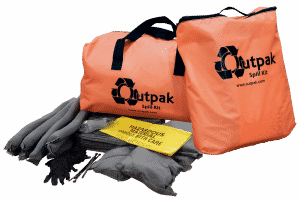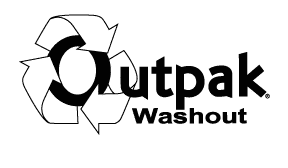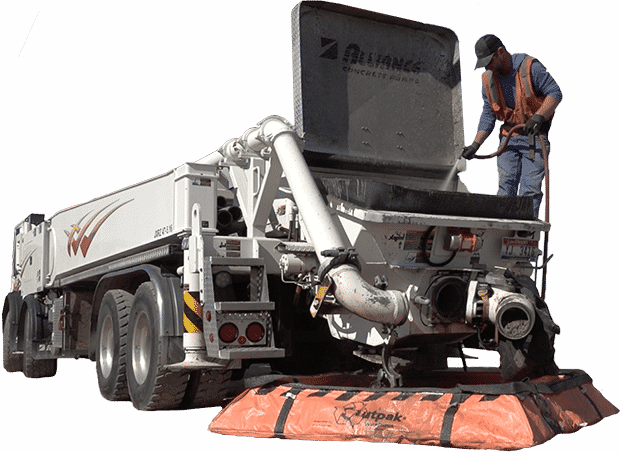Spill kits are a “must have” item for companies with mobile staff that might be in a situation where a chemical or oil spill may occur. Fines are far more expensive than the cost of a spill kit, so it’s important to have at least one in the cab of every truck the company owns.
But what type of spill kit do I need? Should I use a “universal” spill kit over something more specialized. And how do I dispose of the waste when it’s done?
This article includes some answers that may help:
- What is a universal spill kit?
- What do spill kits for oil spills contain?
- What do spill kits for chemical spills contain?
- What state laws for industrial waste spills should I consider?
- Do I even need a spill kit?
What is a Universal Spill Kit?
 A universal spill kit is a type of spill kit that is designed to be used to clean up and contain spills of a wide range of hazardous materials. These kits typically include a variety of absorbent materials, such as pads, booms, and socks, that can be used to soak up and contain liquids of different viscosities and types, including oil, water, and chemicals.
A universal spill kit is a type of spill kit that is designed to be used to clean up and contain spills of a wide range of hazardous materials. These kits typically include a variety of absorbent materials, such as pads, booms, and socks, that can be used to soak up and contain liquids of different viscosities and types, including oil, water, and chemicals.
Universal spill kits may also include other supplies, such as protective gear, cleanup tools, and disposal bags, to help responders safely and effectively manage spills. Some universal spill kits are also equipped with specialized materials, such as neutralizers, that can be used to treat spills of certain types of hazardous materials.
What Do Oil Spill Kits Include?
For oil spills, your spill kit needs to be deployed quickly to absorb oil and keep contamination in check. OSHA rules dictate that a kit needs to be on-hand to collect oil from the largest container on site. If you’re at a facility, your spill response preparation probably includes grading the floor near the containment vessel to lead spills to a trench for easier cleanup.
Portable spill kits, on the other hand, help companies meet OSHA regulations while employees are mobile. For instance, a company truck that has a 25 gallon fuel pump needs to have a spill kit for those 25 gallons. Trucks that transport smaller amounts or have the potential of small oil leaks needs to have a spill kit onboard that meets the potential spill.
We offer a 25 gallon universal spill kit, as well as a 5 gallon spill kit that are compact and easy to store behind the cab of a vehicle.
What Do Spill Kits for Chemical Spills Include?
Choosing a universal oil spill kit is much more cost effective for companies that only haul oil or fuel but not chemicals. Why? The requirements and materials are different. Booms for oil, for instance, don’t need to have properties to absorb and contain caustic chemicals, so they might be cheaper. Also, you’re kit doesn’t need to include as much personal protective gear. Chemical spills, however, require gear to both clean up the spill and to protect workers doing the spill remediation.
And this isn’t us saying this. OSHA requires companies to be able to quickly handle the type of oil or fuel spills they’ll encounter. Having a kit makes it easy to meet those requirements.
 An oil spill that entered a storm drain. Photo Credit: Mike W.
An oil spill that entered a storm drain. Photo Credit: Mike W.
State Law for Industrial Waste Spills
Laws vary from state to state, so you’ll need to check on the laws in your state for how to handle a spill. In Idaho (where Outpak is located), our laws really narrow down to “speed, coverage and disposal”.
#1: Clean Waste Quickly
Cleaning a spill quickly is the goal with most laws. What does “quick” mean for oil spill cleanup? Generally, quick means proving that you can clean a spill quickly is as important as quickly cleaning the spill. For instance, if you don’t have a spill kit ready and the time it takes to get the materials means that the spill has absorbed into the ground or some water runoff channel, then you could be in violation. And oil and fuel spills can be expensive; up to $70,000 in fines!
Having a spill kit on hand that’s suitable for potential spills proves that you’re ready to quickly clean spills that happen.
#2: Clean Waste Completely
Ensuring your spill kit can cover the area of a potential spill is generally also judged on a “case by case” basis. Some states say that you should be ready to protect against a spill of 10% of a containment vessel. Others say that you should be able to contain the enter spill.
We say focus on the spirit of the law and you’ll be protected. If you’re able to cover for the entire spill, then there’s no question that your company would succeed an OSHA review.
#3: Dispose of Waste Fully
Finally, spill kits are one-time use only and must be disposed of according to state rules for the disposal of hazardous waste. For every kit, we suggest including your company procedures on how to dispose of that waste. Reference state rules on disposal to make your policy.
Do I Need a Spill Kit, according to OSHA?

No. You don’t need a kit. What OSHA (and most state regulations) require is that you handle spills quickly. What “speed” is for cleanup is based on the context of your situation, but it’s very difficult to cleanup a spill quickly (or prove that you can clean up a spill quickly) without some type of kit on hand. That’s why having a spill cleanup kit is a cost-effective way to meet OSHA rules and to easily pass OSHA inspection, should you ever get one.
Some companies believe that having a bag of cat litter, some gloves, and a trash bag will also suffice. It’s won’t, because worker safety, public signage, a path to disposal are not addressed. You can create a kit that will work, but the cost and issues related to storage often make DIY solutions cost prohibitive. It’s better to just buy a kit that’s designed to meet OSHA rules so you can focus on the work your company is trained to do.
Can I Use Spill Kits More Than Once?
No. Spill kits are designed for single use. Once the waste is contained, use the spill kit bag to collect the waste and then dispose according to state and OSHA laws.

